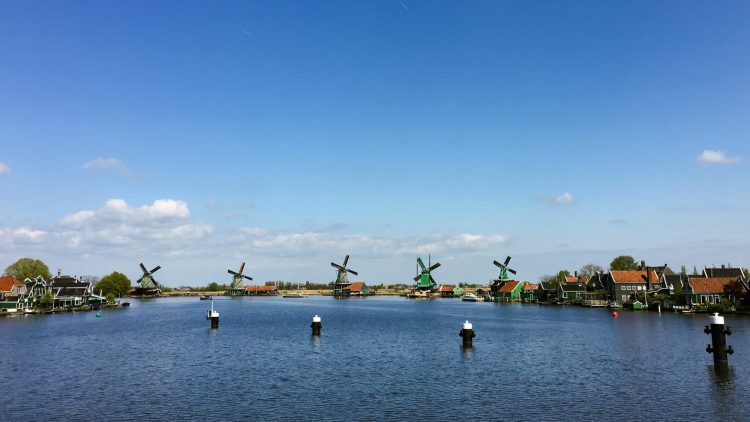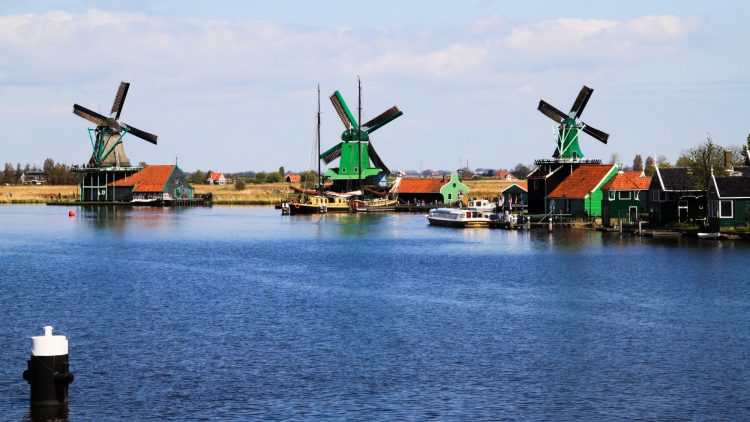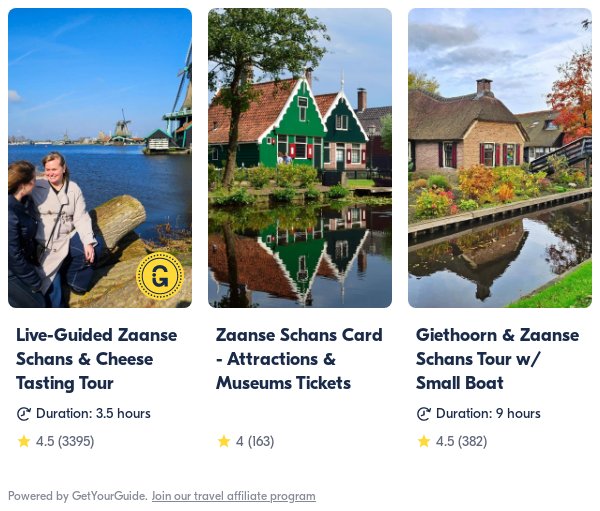The historic working windmills and open-air museum village at Zaanse Schans in Zaandam are a pleasant day-trip destination from Amsterdam in North Holland, the Netherlands.

Historic windmills are of course no longer part of the industrial infrastructure of modern-day Holland but images of a turning windmill are favorite tourist attractions in the Netherlands. Windmills are scattered throughout the Netherlands but the two largest collections of historical working windmills are at Zaanse Schans and at Kinderdijk. The ten historical windmills at Zaanse Schans are within easy reach of Amsterdam and make a great self-guided day trip or tour bus excursion from the Dutch capital. The nineteen windmills at Kinderdijk near Dordrecht and Rotterdam are included on the UNESCO World Cultural Heritage list and are a popular day-trip destination from Dutch cities.
However, getting to Zaanse Schans is far easier from Amsterdam, especially when using public transportation. The additional buildings and museums at Zaanse Schans make the town a more interesting destination than Kinderdijk where the windmills — even though UNESCO listed and higher in number — are the only real attractions.
See Historic Working Windmills at Zaanse Schans near Amsterdam

The ten large windmills at Zaanse Schans are mostly from the seventeenth and eighteenth centuries. Most of the mills were moved to the banks of the Zaan River from the 1960s onwards to form an interesting ensemble. Several historic buildings were added in recent years to form an open-air museum-like appearance.
The lovely village at Zaanse Schans is not a formal museum or indeed an authentic historical village. Many buildings here have historical value but were moved here in order to preserve the buildings. Several house museums and traditional workshops.
De Zaanse Schans is mostly on public land and thus always freely accessible. The museum and mills charge admission — either pay separately or buy a Zaanse Schans Card that covers most admissions.
Industrial Windmills of Zaanse Schans in North Holland

The first windmill along the Zaan River was erected in 1597. Through the centuries more than a thousand were built along the river and during the nineteenth century, 400 windmills were operated simultaneously along the Zaan River. An interactive map in the Zaans Museum shows the development of windmills in the region from 1597 until the last mills went into retirement in the 1930s.
Most of the windmills at Zaanse Schans were moved here from other places in the region while a few are modern reconstructions using traditional techniques.

When viewed from the bridge across the Zaan River, the ten large windmills at Zaanse Schans are from right to left:
- De Huisman (the homeowner, 1786) — a windmill used to grind mustard seeds and other spices.
- De Gekroonde Poelenburg (Crowned Poelen Castle, 1869) — the oldest wood sawmill in the world that is still in use.
- De Kat (the cat, 1664) – a windmill used to grind the elements used in manufacturing paint.
- De Zoeker (the seeker, ca. 1610) – a windmill used to press oil out of seeds.
- Het Jonge Schaap (the young sheep, 2007) — another working wood-sawing windmill. This is a 2007 replica using the building techniques from the original late 17th-century mill. It is usually in use and open to visitors.
- De Os (the ox, 1663) — converted to diesel power in 1916 and now without sails, mostly an oil mill.
- Het Klaverblad (the clover leaf, 2005) — a replica hollow post wood sawmill.
- De Bonte Hen (the speckled hen, 1693) – another oil windmill.
- De Ooievaar (the stork, 1622) — oil mill (on the south side of the bridge)
- De Bleeke Dood (the pale death, 1782) — flour mill (south of the bridge, opposite bank)
Admission to each individual windmill is around €4.50 to €6. Each windmill at Zaanse Schans sets its own opening hours and opening days — some are rarely or never open to the public. The Zaanse Schans Card (€30) includes admission to any two mills, as well as the museums and workshops at Zaanse Scans.
Visit Museums and Traditional Workshops at the Zaanse Schans

The working windmills of Zaanse Schans are the main attraction but the historical buildings forming a small village are also interesting. Five museums are housed here — all covered by the Zaanse Schans Card (€30), or charged individually:
- The Zaans Museum is in the modern visitors’ center and has exhibits on local history, crafts, and industrial development of the region. It also has the Verkade Experience — equipment from a former biscuit and sweets manufacturer where visitors may try the interactive (digital display) to pack sweets and biscuits. (€15)
- The Zaanse Time Museum (previously Dutch Clock Museum / Nederlandse Uurwerk / Zaanse Tijd) illustrates the development of Dutch clocks from the sixteenth to mid-nineteenth centuries. It has very limited information but on a quiet day, the staff loves pointing out interesting details to visitors. (€11)
- The Windmill Museum (Molenmuseum) is a modern new museum at the far end of the windmills. It explains the use and history of windmills with a specific focus on the Zaan region. (€12, or as a World of Windmills ticket including museum and two windmills for €22.)
- The Museum Shop Albert Heijn has the interior of a nineteenth-century grocery store. (free)
- The Bakery Museum (Bakkerij) is a typical nineteenth-century bakery. (free)
Several traditional Dutch crafts are demonstrated in historic workshops. Admission is usually free and often it is possible to follow a big tour group in to see a demonstration. Some of the crafts (ambachten) include cheese making (kaasmakerij), peanut butter (pindakaas), pewter making (tingieterij), the wooden shoe clog workshop (klompenmakerij), weaving (weven – €3), cooper (kuiperij – €3), and distillery (distilleerderij).
Most of these workshops also function as souvenir shops and get very busy at times. Zaanse Schans is a popular tourist destination and never pretends to be anything else. It copes well with mass tourism.
Save with the Zaanse Schans Card

The majority of visitors to Zaanse Schans are on bus group tours and do not enter any of the venues that charge admission. They are not completely wrong, as the main attractions of Zaanse Schans are the windmills, historic houses, beautiful location, and the wonderful panoramic views of the windmills on the banks of the river.
The museums and other venues charging admission are often very quiet inside. These may be seen on individual tickets or are all covered by the Zaanse Schans Card — €30 for a day. It includes admission to the three museums, two windmills, the weaver’s house, and cooperage. It gives a 10% discount at the restaurant De Kraai (very nice pancakes) and reduces parking fees from €15 to €9.
As not all venues are open every day, it is sensible to check opening hours before buying.
See also By Train or Bus to Zaanse Schans in North Holland for general information, restaurant tips, and information on reaching Zaanse Schans on public transportation from Amsterdam, or book a day trip.

